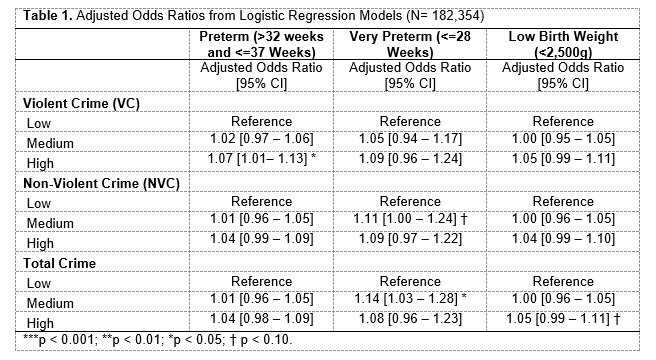Health Equity/Social Determinants of Health
Session: Health Equity/Social Determinants of Health 2
450 - Neighborhood-Level Crime and Birth Outcomes: An Analysis of Crime Type in Three Urban Ohio Counties
Friday, May 3, 2024
5:15 PM - 7:15 PM ET
Poster Number: 450
Publication Number: 450.425
Publication Number: 450.425

Brittany M. Mosley, MPH (she/her/hers)
Clinical Research Coordinator II
Nationwide Children's Hospital
Columbus, Ohio, United States
Presenting Author(s)
Background: The Black-White racial disparity in infant mortality rates in the US have persisted for decades. Research has sought to understand factors contributing to preterm birth (PTB) and low birth weight (LBW), as they are the leading causes of infant death. A growing body of literature indicates that neighborhood-level factors play a significant role in birth outcome trends. While understudied, literature suggests that the stress associated with living in neighborhoods with high crime rates can lead to poor birth outcomes.
Objective: To assess the association between birth outcomes and community violence in three Ohio counties with high infant mortality racial disparities.
Design/Methods: Birth record data (2018-2022) for singleton births in Franklin, Hamilton, and Cuyahoga counties (N= 182,354) were linked to crime data in the year preceding the birth from Ohio-Incident-Based Reporting System at the census tract level. Annual crime rates per 1,000 residents, classified as violent (VC), nonviolent (NVC), and total crime, were calculated using geocoded crime incidents and categorized into tertiles (i.e., low, medium, and high crime) for analyses. Logistic regression models were used to estimate the effects of crime on birth outcomes including PTB (>32 weeks and <= 37 weeks gestation), very PTB (vPTB, <= 28 weeks gestation), and LBW ( < 2500 grams) births. All models controlled for race/ethnicity, maternal age, risk factors for poor birth outcomes, marital status, maternal education, parity, insurance status, smoking status, poverty status, and prenatal care.
Results: Compared to birthing people who live in areas with low VC, the odds of PTB were significantly greater among those in high VC areas (aOR:1.066; p-value= 0.02). The odds of vPTB were marginally higher among those in medium NVC areas compared to low NVC areas (aOR: 1.11; p-value=0.055). Living in a medium total crime area, however, was significantly associated with greater odds of vPTB compared to birthing people in low total crime areas (aOR:1.14; p-value=0.015). Neither crime type was significantly associated with LBW.
Conclusion(s): Neighborhood-level VC and NVC rates had varying effects on birth outcomes in medium and high crime areas compared to low crime areas. Recognizing that neighborhoods are racially segregated due to structural racism and discrimination, future analyses should stratify by race/ethnicity to assess potential differences in the effect of crime on identified birth outcomes. Understanding the impacts of social environments on birth outcomes can inform collaborative intervention by health systems and communities.

